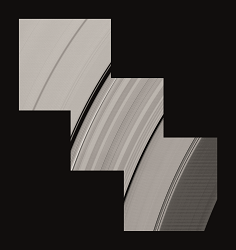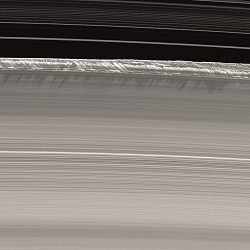 Matthew Hedman has written about periodic brightness variations in the rings visible in the high-resolution images only when the Sun is edge-on — actual ripples generated by some impact event that happened in the 1980s and still reverberating. Matthew Hedman is assistant professor at the University of Idaho (USA). His expertise focuses on planetary rings, and he worked on Cassini data from the VIMS spectrometer and the Narrow Angle Camera of the ISS imaging system.
Matthew Hedman has written about periodic brightness variations in the rings visible in the high-resolution images only when the Sun is edge-on — actual ripples generated by some impact event that happened in the 1980s and still reverberating. Matthew Hedman is assistant professor at the University of Idaho (USA). His expertise focuses on planetary rings, and he worked on Cassini data from the VIMS spectrometer and the Narrow Angle Camera of the ISS imaging system.
 Linda Spilker selected an unique view of the rings, possible only every 15 years at equinoxes when the Sun illuminates the rings edge-on (like the image above), which allowed the observation of the shadows of the bigger ring particles on the plane of the rings. Linda Spilker works at the Jet Propulsion Laboratory (JPL) in Pasadena (USA) and is Project Scientist for the Cassini mission.
Linda Spilker selected an unique view of the rings, possible only every 15 years at equinoxes when the Sun illuminates the rings edge-on (like the image above), which allowed the observation of the shadows of the bigger ring particles on the plane of the rings. Linda Spilker works at the Jet Propulsion Laboratory (JPL) in Pasadena (USA) and is Project Scientist for the Cassini mission.

